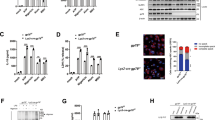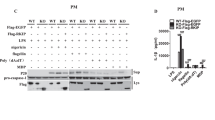Abstract
The NLRP3 inflammasome has a major role in regulating innate immunity. Deregulated inflammasome activity is associated with several inflammatory diseases, yet little is known about the signaling pathways that lead to its activation. Here we show that NLRP3 interacted with thioredoxin (TRX)-interacting protein (TXNIP), a protein linked to insulin resistance. Inflammasome activators such as uric acid crystals induced the dissociation of TXNIP from thioredoxin in a reactive oxygen species (ROS)-sensitive manner and allowed it to bind NLRP3. TXNIP deficiency impaired activation of the NLRP3 inflammasome and subsequent secretion of interleukin 1β (IL-1β). Akin to Txnip−/− mice, Nlrp3−/− mice showed improved glucose tolerance and insulin sensitivity. The participation of TXNIP in the NLRP3 inflammasome activation may provide a mechanistic link to the observed involvement of IL-1β in the pathogenesis of type 2 diabetes.
This is a preview of subscription content, access via your institution
Access options
Subscribe to this journal
Receive 12 print issues and online access
$209.00 per year
only $17.42 per issue
Buy this article
- Purchase on SpringerLink
- Instant access to full article PDF
Prices may be subject to local taxes which are calculated during checkout








Similar content being viewed by others
References
Martinon, F., Mayor, A. & Tschopp, J. The inflammasomes: guardians of the body. Annu. Rev. Immunol. 27, 229–265 (2009).
Chen, G., Shaw, M.H., Kim, Y.G. & Nuñez, G. Nod-like receptors: role in innate immunity and inflammatory disease. Ann. Rev. Pathol. 4, 365–398 (2009).
Agostini, L. et al. NALP3 forms an IL-1β processing inflammasome with increased activity in Muckle-Wells auto-inflammatory disorder. Immunity 20, 319–325 (2004).
Mariathasan, S. et al. Differential activation of the inflammasome by caspase-1adaptors ASC and Ipaf. Nature 430, 213–218 (2004).
Martinon, F., Agostini, L., Meylan, E. & Tschopp, J. Identification of bacterial muramyl dipeptide as activator of the NALP3/cryopyrin inflammasome. Curr. Biol. 14, 1929–1934 (2004).
Martinon, F., Petrilli, V., Mayor, A., Tardivel, A. & Tschopp, J. Gout-associated uric acid crystals activate the NALP3 inflammasome. Nature 440, 237–241 (2006).
Halle, A. et al. The NALP3 inflammasome is involved in the innate immune response to amyloid-β. Nat. Immunol. 9, 857–865 (2008).
Petrilli, V. et al. Activation of the NALP3 inflammasome is triggered by low intracellular potassium concentration. Cell Death Differ. 14, 1583–1589 (2007).
Franchi, L. et al. Critical role for Ipaf in Pseudomonas aeruginosa-induced caspase-1 activation. Eur. J. Immunol. 37, 3030–3039 (2007).
Marina-Garcia, N. et al. Pannexin-1-mediated intracellular delivery of muramyl dipeptide induces caspase-1 activation via cryopyrin/NLRP3 independently of Nod2. J. Immunol. 180, 4050–4057 (2008).
Hornung, V. et al. Silica crystals and aluminum salts activate the NALP3 inflammasome through phagosomal destabilization. Nat Immunol 9, 847–856 (2008).
Kim, S.Y., Suh, H.W., Chung, J.W., Yoon, S.R. & Choi, I. Diverse functions of VDUP1 in cell proliferation, differentiation, and diseases. Cell. Mol. Immunol. 4, 345–351 (2007).
Kaimul, A.M., Nakamura, H., Masutani, H. & Yodoi, J. Thioredoxin and thioredoxin-binding protein-2 in cancer and metabolic syndrome. Free Radic. Biol. Med. 43, 861–868 (2007).
Dostert, C. et al. Innate immune activation through Nalp3 inflammasome sensing of asbestos and silica. Science 320, 674–677 (2008).
Nishiyama, A. et al. Identification of thioredoxin-binding protein-2/vitamin D3 up-regulated protein 1 as a negative regulator of thioredoxin function and expression. J. Biol. Chem. 274, 21645–21650 (1999).
Chen, J., Saxena, G., Mungrue, I.N., Lusis, A.J. & Shalev, A. Thioredoxin-interacting protein: a critical link between glucose toxicity and beta-cell apoptosis. Diabetes 57, 938–944 (2008).
Parikh, H. et al. TXNIP regulates peripheral glucose metabolism in humans. PLoS Med. 4, e158 (2007).
van Greevenbroek, M.M. et al. Genetic variation in thioredoxin interacting protein (TXNIP) is associated with hypertriglyceridaemia and blood pressure in diabetes mellitus. Diabet. Med. 24, 498–504 (2007).
Minn, A.H., Hafele, C. & Shalev, A. Thioredoxin-interacting protein is stimulated by glucose through a carbohydrate response element and induces beta-cell apoptosis. Endocrinology 146, 2397–2405 (2005).
Turturro, F., Friday, E. & Welbourne, T. Hyperglycemia regulates thioredoxin-ROS activity through induction of thioredoxin-interacting protein (TXNIP) in metastatic breast cancer-derived cells MDA-MB-231. BMC Cancer 7, 96 (2007).
Maedler, K. et al. Glucose- and interleukin-1beta-induced beta-cell apoptosis requires Ca2+ influx and extracellular signal-regulated kinase (ERK) 1/2 activation and is prevented by a sulfonylurea receptor 1/inwardly rectifying K+ channel 6.2 (SUR/Kir6.2) selective potassium channel opener in human islets. Diabetes 53, 1706–1713 (2004).
Dasu, M.R., Devaraj, S. & Jialal, I. High glucose induces IL-1β expression in human monocytes: mechanistic insights. Am. J. Physiol. Endocrinol. Metab. 293, E337–E346 (2007).
Suh, S.W. et al. Glucose and NADPH oxidase drive neuronal superoxide formation in stroke. Ann. Neurol. 64, 654–663 (2008).
Gokulakrishnan, K., Mohanavalli, K.T., Monickaraj, F., Mohan, V. & Balasubramanyam, M. Subclinical inflammation/oxidation as revealed by altered gene expression profiles in subjects with impaired glucose tolerance and type 2 diabetes patients. Mol. Cell. Biochem. 324, 173–181 (2009).
Hattersley, A.T. & Ashcroft, F.M. Activating mutations in Kir6.2 and neonatal diabetes: new clinical syndromes, new scientific insights, and new therapy. Diabetes 54, 2503–2513 (2005).
Muruve, D.A. et al. The inflammasome recognizes cytosolic microbial and host DNA and triggers an innate immune response. Nature 452, 103–107 (2008).
Lamkanfi, M. et al. Glyburide inhibits the cryopyrin/Nalp3 inflammasome. J. Cell Biol. 187, 61–70 (2009).
Lee, K.N. et al. VDUP1 is required for the development of natural killer cells. Immunity 22, 195–208 (2005).
Son, A. et al. Dendritic cells derived from TBP-2-deficient mice are defective in inducing T cell responses. Eur. J. Immunol. 38, 1358–1367 (2008).
Chen, J. et al. Thioredoxin-interacting protein deficiency induces Akt/Bcl-xL signaling and pancreatic β-cell mass and protects against diabetes. FASEB J. 22, 3581–3594 (2008).
Hui, S.T. et al. Txnip balances metabolic and growth signaling via PTEN disulfide reduction. Proc. Natl. Acad. Sci. USA 105, 3921–3926 (2008).
Oka, S.I. et al. Thioredoxin binding protein-2 (TBP-2)/Txnip is a critical regulator of insulin secretion and PPAR function. Endocrinology 155, 1225–1234 (2008).
Mayor, A., Martinon, F., De Smedt, T., Petrilli, V. & Tschopp, J. A crucial function of SGT1 and HSP90 in inflammasome activity links mammalian and plant innate immune responses. Nat. Immunol. 8, 497–503 (2007).
Dostert, C. et al. Malarial hemozoin is a Nalp3 inflammasome activating danger signal. PLoS One 4, e6510 (2009).
Larsen, C.M. et al. Interleukin-1-receptor antagonist in type 2 diabetes mellitus. N. Engl. J. Med. 356, 1517–1526 (2007).
Didierlaurent, A. et al. Tollip regulates proinflammatory responses to interleukin-1 and lipopolysaccharide. Mol. Cell. Biol. 26, 735–742 (2006).
Gotoh, M. et al. Reproducible high yield of rat islets by stationary in vitro digestion following pancreatic ductal or portal venous collagenase injection. Transplantation 43, 725–730 (1987).
Papin, S. et al. The SPRY domain of Pyrin, mutated in familial Mediterranean fever patients, interacts with inflammasome components and inhibits proIL-1β processing. Cell Death Differ. 14, 1457–1466 (2007).
Acknowledgements
We thank P. Vandenabeele (Ghent University) for antibody to mouse caspase-1 (p20); V. Dixit (Genentech) for Ipaf−/− mice; R.V. Bruggen (Free University Amsterdam) for S. typhimurium; R. Solari (Glaxo) for antibody to mouse IL-1β; M. Joffraud for technical help; and K. Schroder, C. Dostert and O. Gross for reading the manuscript. Supported by the Swiss National Science Foundation, MUGEN and the Swiss National Center of Competence in Research for Molecular Oncology (A.T.).
Author information
Authors and Affiliations
Contributions
R.Z. and J.T. designed the study and wrote the manuscript; R.Z. and A.T. did experiments; I.C. provided mice; and B.T. provided technical support and conceptual advice.
Corresponding author
Supplementary information
Supplementary Text and Figures
Supplementary Figures 1–6 (PDF 721 kb)
Rights and permissions
About this article
Cite this article
Zhou, R., Tardivel, A., Thorens, B. et al. Thioredoxin-interacting protein links oxidative stress to inflammasome activation. Nat Immunol 11, 136–140 (2010). https://doi.org/10.1038/ni.1831
Received:
Accepted:
Published:
Issue Date:
DOI: https://doi.org/10.1038/ni.1831



